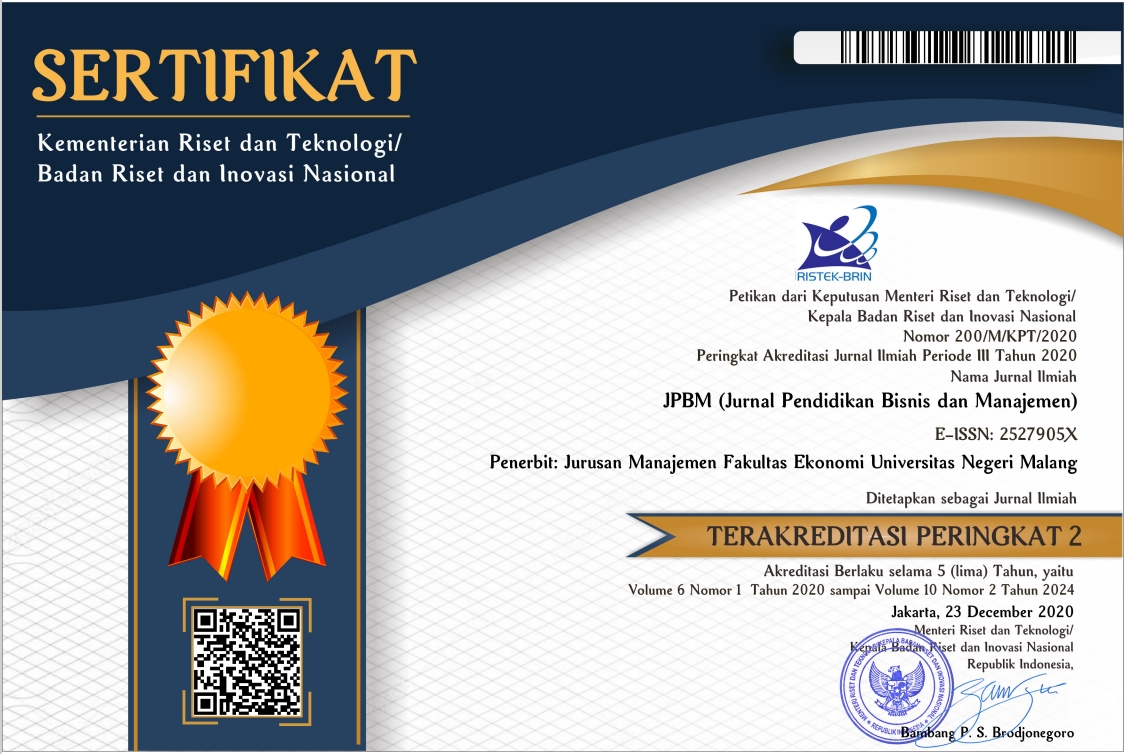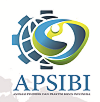Author Guidelines
General Guidelines
Manuscript submitted to the JPBM (Jurnal Pendidikan Bisnis dan Manajemen) should be original contributions and should not be under consideration for any publication at the same time. We are especially interested in research and critical thinking related to business education and management. Manuscripts accepted is written in Bahasa Indonesia or English. All authors of a manuscript should include their full name and affiliation(s). One author should be identified as the corresponding author. He/she must include an email address. Please note that once published, your email address will normally be displayed in the article permanently.
Article Components
Manuscripts should be compiled in the following order: title; abstract; keywords; main text (consist of introduction; method; results and discussion; conclusion); references.
Title and Abstract. The title and the abstract are key elements that inform the reader of the contents of the manuscript. Given the title’s prominence, authors should exercise thought and creativity in selecting a title that will capture the reader’s attention and clearly inform the reader of the contents within. Similarly, the abstract is read by far more readers than is the average article. The abstract serves important purposes in summarizing the hypothesis, design, and findings of the study and in representing the article in indexing databases. The abstract contains an introduction, method, results, and discussion. The abstract should be provided approximately 150 to 200 words, 3-5 Keywords
Introduction. A robust introduction engages the reader in the problem of interest and provides a context for the study at hand. In introducing the research concern, the writer should provide a clear rationale for why the problem deserves new research, placing the study in the context of current knowledge and prior theoretical and empirical work on the topic. The novelty, research gap, and contribution need to be provided in this section.
Methods. In both quantitative and qualitative research, the use of appropriate methods of participants sampling, study design, measures, and statistical analysis critically influences the study’s methodological soundness. A good methodology should be clean and clear. Clean means the use of appropriate, valid, and unflawed methods of sampling and use of instruments, procedures, and analysis. Clear means the ideal method is written in a clear manner, such that another researcher could duplicate the study.
Results and Discussion. The results section should include a summary of the collected data and analyses, which follows from the analytic plan. All results should be described, including unexpected findings. Authors should include both descriptive statistics and test of significance.
In the discussion session, the authors evaluate and interpret the findings. This section should begin with a statement of support or nonsupport for the original hypotheses in light of the findings. If the hypotheses were not supported, the author considers post hoc explanations. In interpreting the results, authors consider sources of bias and other threats to internal validity, imprecision of measures, overall number of tests, or overlap among tests, effect sizes, and other weaknesses of the study.
Conclusion. In a conclusion, authors summarize the findings and explain the implications of work. It contains no new data or findings. The authors may also include recommendations for improvements to the apparatus or method, or suggestions for future research on the subject at hand.
Acknowledgement (If any)
Tables and Figures. Table and figures are particularly valuable for conveying large amounts of information and for showing relationships among data. However, tables and figures should be kept to a minimum and contain only essential data. All diagrams, charts, and graphs should be referred to as figures and provided in high quality. It is the authors’ responsibility to make sure to obtain permissions to display tables and figures from third parties.
References. In the references section, only include previous works that cited in the text. References should be cited in the text according to Havard Citation Format. The reference list should include every work cited in the text. Please ensure that dates, spelling, and title used in the text are consistent with those listed in the references. Please use Reference Manager Applications like EndNote, Mendeley, Zotero, etc.
e-Book
Bransford, J. D., Brown, A. L., & Cocking, R. R. (2005). How people learn: Brain, mind, experience and school. from https://www.nap.edu/catalog/9853/how-people-learn-brain-mind-experience-and-school-expanded-edition.
Book
Schunk, D. H. (2012). Learning theories an educational perspective. Boston, MA: Pearson Education, Inc.
Journal
Narmaditya, B. S., Agustina, Y., Handayani, S., Rokhmani, L., Hardinto, P., Munir, S., ... & Irwansyah, M. R. (2021). Synchronous learning with STEM and economics students’ critical thinking abilities. JPBM (Jurnal Pendidikan Bisnis dan Manajemen), 7(2), 93-99. http://dx.doi.org/10.17977/um003v7i22021p93
Nurgiyantoro, B., & Efendi, A. (2017). Re-actualizationof puppet characters in modern Indonesian fictions of the 21stCentury. 3L: The Southeast Asian Journal of English Language Studies. 23(2),141-153. http://doi.org/10.17576/3L-2017-2302-11.
Retnowati, E., Fathoni, Y., & Chen, O. (2018). Mathematics Problem Solving Skill Acquisition: Learning by Problem Posing or by Problem Solving? Cakrawala Pendidikan, 37(1), 1-10 http://dx.doi.org/10.21831/cp.v37i1.18787.
Wijijayanti, T., Agustina, Y., Winarno, A., Istanti, L. N., & Dharma, B. A. (2020). Rural tourism: A local economic development. Australasian Accounting, Business and Finance Journal, 14(1), 5-13.
In more detail, the journal template can be download
here
















